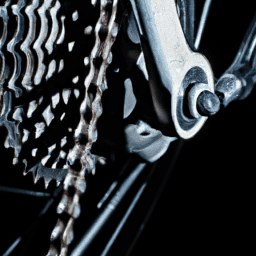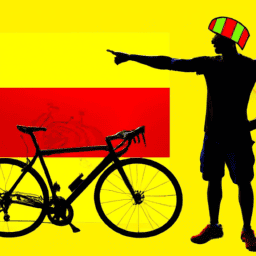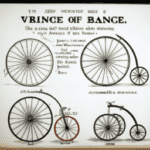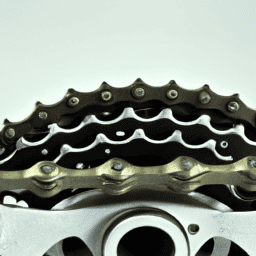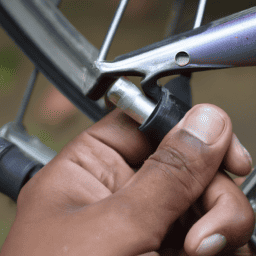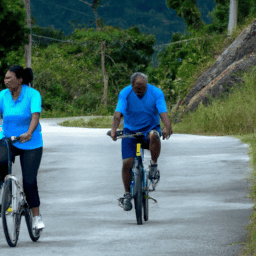As someone who is passionate about cycling, I’ve always been intrigued by how bicycles work. Were you aware that the invention of the bicycle dates back to 1817, and it has evolved into a widely used form of transport across the globe?
According to a survey conducted by the World Health Organization, over 1 billion people around the world use bicycles as their primary mode of transportation.
But have you ever wondered how a bicycle actually works? In this article, I will take a technical and detailed look at the basic components of a bicycle, how pedaling and propulsion work together to move the bike forward, how braking and stopping are achieved, and the physics behind stability and balance while riding.
Whether you are a seasoned cyclist or just curious about the mechanics of this beloved mode of transportation, read on to learn more about how a bicycle works.
Key Takeaways
- The frame of a bicycle is made of lightweight yet durable metal and provides support and structure to the bike.
- Pedaling transfers muscle power to the chain mechanism, which is responsible for transferring energy to the rear wheel. Gears create gearing ratios for resistance and speed.
- Brakes are important for effective stopping and avoiding tipping over. Applying brakes evenly and simultaneously is necessary for good braking performance.
- Regular inspections and repairs are necessary for good working order of a bike. Tools such as tire levers, pumps, Allen wrenches, chain lubricant, and patch kit are needed to fix issues like flat tires, loose bolts, and squeaky chains.
The Basic Components of a Bicycle
Let’s take a closer look at the fundamental parts of a bike, so you can better understand how this two-wheeled wonder operates.
The bicycle frame is the foundation of the bike, providing support and structure to all other components. Most frames are made of metal, such as steel, aluminum, or titanium, and are designed to be lightweight yet durable. The frame usually consists of a top tube, down tube, seat tube, and chainstays, all connected by welds or bolts. The shape of the frame can vary greatly depending on the type of bike, with road bikes featuring a more aerodynamic design and mountain bikes featuring a more rugged and sturdy design.
The wheel design is also a crucial component of a bicycle, as it determines the bike’s stability and maneuverability. A typical bike has two wheels, each consisting of a hub, spokes, and rim. The hub is the central part of the wheel that connects to the bike’s frame, while the spokes are the thin metal rods that radiate out from the hub to the rim. The rim is the outer circular part of the wheel that holds the tire in place. The size and shape of the wheel can vary depending on the type of bike, with road bikes featuring larger and thinner wheels for speed and mountain bikes featuring smaller and wider wheels for better traction on rough terrain.
With a solid understanding of the bike’s frame and wheel design, we can now move onto the next section about pedaling and propulsion.
Pedaling and Propulsion
When I pedal my bike, I can feel the power transfer from my legs to the pedals, which in turn propels the bike forward. Understanding gears is crucial to optimizing this motion, as it allows me to adjust the resistance and speed at which I pedal.
By finding the right balance between gear ratios and resistance, I can efficiently and effectively propel myself forward on my bike.
How Pedaling Propels the Bike Forward
By pushing down on the pedals, the cyclist transfers their muscle power to the chain mechanism, which then propels the bike forward. The chain mechanism is responsible for transferring the energy from the pedals to the rear wheel, which causes the bike to move forward.
As the cyclist pushes down on the pedals, the chain rotates and moves the rear wheel forward, which propels the bike forward. It’s important to note that the cyclist’s pedaling motion must be smooth and consistent for the chain mechanism to transfer energy efficiently.
Any sudden jerks or pauses in pedaling can cause the chain to slip, which can result in a loss of momentum and speed. Understanding how to pedal smoothly and consistently is crucial for maximizing the efficiency of the chain mechanism and propelling the bike forward with minimal effort.
Now let’s move on to understanding how gears and resistance play a role in cycling.
Understanding Gears and Resistance
To truly understand how gears and resistance affect your cycling experience, you must first grasp the basic principles of how they interact with your body’s energy output.
Gears are essentially a set of wheels with different diameters that work together to transfer energy from your legs to the wheels. The different sizes of the gears create gearing ratios, which determine how much force is required to turn the wheels.
Here are some key points to keep in mind when it comes to gears and resistance:
- The smaller the gear, the easier it is to pedal, but the slower you’ll go.
- The larger the gear, the harder it is to pedal, but the faster you’ll go.
- Changing gears can help you maintain a comfortable level of resistance while cycling on different terrains.
- Proper chain tension is essential for smooth shifting between gears and optimal power transfer.
Understanding how gearing ratios and resistance work together can greatly improve your cycling experience. With the right knowledge and techniques, you can optimize your performance and enjoy a smooth ride.
Speaking of smooth rides, let’s move on to the next topic: braking and stopping.
Braking and Stopping
If you want to ensure a safe and smooth ride on your bicycle, understanding how to brake and stop effectively is crucial.
There are two main types of brakes on a bicycle: rim brakes and disc brakes. Rim brakes work by pressing rubber pads against the rim of the wheel, whereas disc brakes work by squeezing a metal rotor attached to the wheel hub.
Both types of brakes use the physics of friction to slow down and stop the bicycle. To stop a bicycle effectively, it is important to apply the brakes evenly and gradually. Sudden and jerky movements can cause the wheels to skid and lose traction, leading to a loss of control and balance.
Additionally, it is important to use both brakes simultaneously, as relying too heavily on one brake can cause the bicycle to tip over. By mastering the art of braking and stopping, you can ensure a safe and enjoyable ride on your bicycle.
As important as braking and stopping are, stability and balance are just as crucial for a smooth and safe ride.
Stability and Balance
Maintaining stability and balance while riding your bike is essential for a smooth and enjoyable experience, as you weave through the wind and glide down the road. One of the most important factors affecting your bike’s stability and balance is the center of gravity. The center of gravity is the point at which the bike’s weight is evenly distributed, and it determines how easy or difficult it is to control your bike. When the center of gravity is low, it is easier to balance and control your bike. This is why bikes are designed with a low center of gravity, usually located near the bottom bracket, where the pedals attach to the frame.
Another factor that affects your bike’s stability and balance is countersteering. Countersteering is the process of turning the handlebars in the opposite direction of the turn in order to initiate the turn. This might sound counterintuitive, but it is a necessary technique that helps you maintain stability and balance while turning. When you turn the handlebars in the opposite direction, it causes the bike to lean in the direction of the turn. This lean helps you maintain your balance and stability while turning, and it also helps you control the bike’s trajectory. By practicing countersteering, you can improve your ability to maintain stability and balance while riding your bike.
To ensure that your bike remains stable and balanced, it is important to keep it well-maintained. This includes regular inspections and repairs to keep all components in good working order. By taking care of your bike, you can enjoy a smooth and stable ride for years to come.
Maintenance and Repair
As you cruise down the road with the wind in your hair, you can ensure your bike stays in top shape by regularly checking and fixing any issues that arise. One of the essential parts of maintenance and repair is having the right tools.
Some of the tools needed include tire levers, a pump, a set of Allen wrenches, chain lubricant, and a patch kit. These tools will help you fix common issues such as a flat tire, loose bolts, and a squeaky chain.
One of the most common issues that arise in a bike is a flat tire. To fix this, you should first remove the wheel using your Allen wrenches and tire levers. Once the tire is off, locate the puncture and use the patch kit to repair it.
Another common issue is a loose bolt, which can be fixed by tightening it with a wrench.
Finally, a squeaky chain can be lubricated with chain lubricant to reduce friction and noise. By regularly checking and fixing these issues, you can ensure that your bike stays in top shape and extends its lifespan.
Frequently Asked Questions
What is the history of the bicycle and how has it evolved over time?
The bicycle has undergone numerous evolutionary milestones since its inception in the early 19th century. Its cultural impact has been immense, affecting transportation, leisure, and sports. Its design has been refined over time to improve efficiency, comfort, and safety.
What are the different types of bicycles and what are their specific uses?
I’ve investigated the theory that different types of bicycles have specific uses. When it comes to fitness, Mountain bikes are better for off-road terrain while Road bikes are ideal for longer rides. Folding bikes are more eco-friendly than electric bikes.
How do you properly fit a bicycle to your body size and shape?
To properly fit a bicycle to my body shape and size, I adjust the handlebars and saddle height. I start by measuring my inseam and adjusting the saddle height accordingly. Then, I adjust the handlebars to a comfortable position for my arms and shoulders.
What are some common safety measures to take while riding a bicycle?
Riding a bicycle safely requires preparation and awareness. Hand signals are crucial to communicate turns and stops. Wearing a helmet is essential to protect your head in case of an accident. Always stay alert and follow traffic laws.
How can you improve your overall cycling performance and endurance?
To improve my cycling performance and endurance, I focus on interval training and nutrition planning. Interval training involves alternating high and low intensity workouts, while nutrition planning ensures I have enough energy to sustain long rides.
Conclusion
Well, there you have it, folks. That’s how a bicycle works. It may seem like a simple machine, but there are many components and mechanics that work together to make it function properly.
From the frame to the pedals, from the brakes to the wheels, every part plays an important role in the bike’s operation. But a bicycle is more than just a machine. It’s a tool that can take you on incredible adventures and provide a sense of freedom and joy that’s hard to match.
Riding a bike can make you feel like you’re flying, and it’s a feeling that’s hard to describe until you’ve experienced it yourself. So, don’t be afraid to hop on a bike and give it a spin. You might just be surprised at where it can take you.
After all, the possibilities are endless when you’re riding on two wheels.
